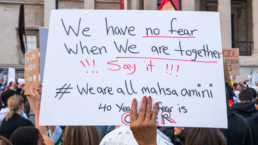‘We have given the power of the world and its leadership over to women! O you women of the world, be you responsible with it, if you be just and fair!’ – First Gate of the Fifteenth Unity of the Bayān
By Wahid Azal, Counterpunch
As several historical narratives have detailed,[1] during the summer of 1848 as revolutions were raging across Europe, and closely contemporaneous with the publication of the Communist Manifesto by Marx and Engels; an ancestor of mine and iconclastic revolutionary Bābī leader and Iranian Shiʿite woman hailed by the Bāb as the ‘return’of Fāṭima (i.e. the prophet Muḥammad’s daughter), and known to posterity as Ṭāhirih Qurrat’ul-ʿAyn (the Pure Solace of the Eyes) (d. 1852), appeared publicly unveiled atop a make-shift dā’is in the hamlet of Badasht northern Iran, Semnan province, where Bābī leaders and laity had gathered at the time on their leader’s behest, i.e. the Bāb (himself incarcerated at the time in Iranian Azerbaijān), in order to determine the fate of their movement. Creating an uproar that resonates to this very day by scandalizing the orthodox religious establishment for appearing publicly unveiled, there Qurrat’ul-ʿAyn is apparently credited for proclaiming the abrogation of the Islamic dispensation altogether with its sharīʿa, declaring her own divinity in the process, while promulgating a new scripture on behalf of the Bāb superceding the Qurān known as the Bayān (exposition). A few accounts have dramatized words uttered by her to the effect that, ‘I am the word which the Qāʾim [i.e. the Islamic messiah] has uttered putting the kings and rulers of the earth to flight!’[2]

Four years later in the late summer of 1852, as the absolutist Qājār monarchy and its reactionary clerical allies had struggled on the brink of collapse to put down Bābī uprisings throughout Iran with the heresy it represented to them; and following a four year incarceration by government forces as a vocal religio-political dissident; on the back of a failed Bābī assassination attempt on the life of the Qājār monarch, Nāṣiruddīn Shāh (d. 1896); by royal edict Qurrat’ul-ʿAyn was strangled to death with her body buried somewhere in the royal gardens (bāgh-i-ilkhānī) of Tehran.[3] Although neither Bahāism nor a modern Iranian feminist movement were to emerge for a few more decades yet from 1852, both movements have subsequently claimed her as theirs, and often for contradictory reasons. Twentieth century Iranian feminists and activists such as Sadīqa Dawlatābādī (d. 1961)[4] or the modernist poet and iconoclast Forough Farrokhzād (d. 1967)[5] were inspired by her example. There is even speculation that the Islamo-Marxist ideologue of the Islamic Revolution himself, ʿAlī Sharīʿatī (d. 1977),[6] was secretly a Bābī – his uncompromising anti-clericalism being implicit evidence to that end, not to mention that his late wife never donned the ḥijāb until forced to by the Khomeinist state. Sharīʿatī’s series of Hosseiniyah-Ershād lectures bound as a single volume, entitled ‘Fāṭima is Fāṭima’ (fāṭima, fāṭima hast),[7] also seems to be a bow to Qurrat’ul-ʿAyn rather than the Fāṭima of orthodox Shiʿite piety.
Recent Posts
‘Unconstitutional. Unethical. Authoritarian.’ ICE Bars Millions Of Immigrants From Bond Hearings
July 18, 2025
Take Action Now One watchdog said the new policy “seems like a blatant attempt to stop them from exercising their right to due process.”……
Americans Are Not Nearly Alarmed Enough About Climate Change
July 18, 2025
Take Action Now Americans still don’t comprehend how imminent, dangerous, and far-reaching the threat is—and journalists are partly to blame.By…
The IRS Is Building A Vast System To Share Millions Of Taxpayers’ Data With ICE
July 17, 2025
Take Action Now ProPublica has obtained the blueprint for the Trump administration’s unprecedented plan to turn over IRS records to Homeland Security…
Israel’s Sudden Assault On Syria Is Unchecked Aggression
July 17, 2025
Take Action Now Jerusalem is bombing Damascus and threatening al-Sharaa’s rule, while Washington was hoping to help the nascent government on…




